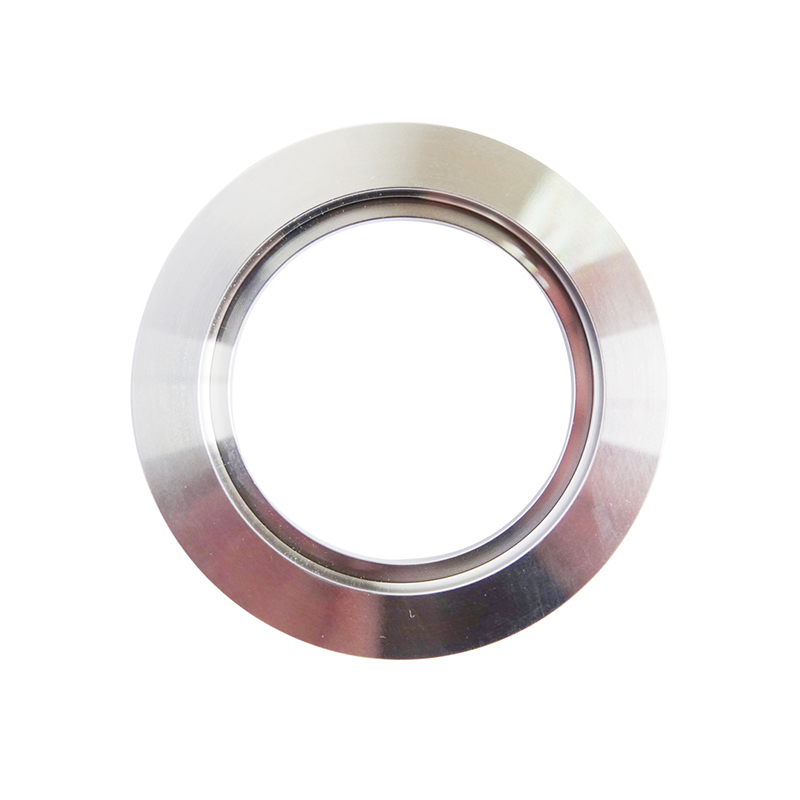In the vacuum industry, the CF, KF, and ISO flange types exhibit significant differences in structure, sealing methods, application scenarios, and characteristics. Below is a detailed comparison of these three flange types:
I. Structural Differences
1. CF Flange
Full name: Conflat Flange, a detachable metal static seal flange.
It is divided into two types: fixed and loose-sleeve. The fixed-type flange has an integrated structure, while the loose-sleeve type flange consists of a blade part that compresses the copper gasket and a fixed part secured by bolts.
The flange can have through-holes or threaded holes. Flanges with through-holes are fixed using bolts and nuts, while those with threaded holes can be directly fixed using bolts.
- KF Flange
A quick-disconnect connection used in vacuum systems.
It is composed of two symmetrically distributed KF flanges, an O-Ring (seal ring), centering bracket, clamp, and other components.
- ISO Flange
ISO flanges and piping can be used in various applications ranging from atmospheric pressure to high vacuum.
It is divided into two forms: ISO-K and ISO-F. ISO-K flanges typically consist of a flange, flange claws (or double claws), seal ring, and centering ring; ISO-F flanges consist of a flange, seal ring, and centering ring, with the flange secured by bolts.
Compared to the vacuum seal rings of the KF series, the seal rings of the ISO series have an additional aluminum spring outer ring, mainly to prevent the seal ring from slipping off, in addition to the centering bracket and fluororubber seal ring.
II. Sealing Methods
1. CF Flange
Uses oxygen-free copper sealing. The oxygen content of the oxygen-free copper gasket is less than 0.003%, with a total impurity content not exceeding 0.05%, and no hydrogen embrittlement, providing good corrosion resistance and low-temperature performance.
The inside of the flange has a protruding sharp blade that compresses the oxygen-free copper gasket (or other soft metal) to deform and achieve vacuum sealing, which is a sealing method using all-metal materials.
- KF Flange
Typically uses rubber seal rings, such as Viton, Buna, Silicone, EPDM, and other materials.
The seal ring is placed on the centering ring (or centering bracket) and positioned between the two flanges to achieve sealing.
- ISO Flange
Also uses O-rings for sealing, with diverse materials such as Viton, Buna, Silicone, EPDM, and aluminum wire.
The seal ring is also placed on the centering ring and achieves sealing through the tight fit between the flanges and the fixing action of the claws (or bolts).
III. Application Scenarios and Characteristics
1. CF Flange
Primarily used in ultra-high vacuum equipment, such as particle accelerators, synchrotron radiation light sources, and other high-energy physics experimental devices.
Can withstand high-temperature baking (above 250°C), suitable for vacuum systems requiring high-temperature processing.
Offers stable and reliable sealing performance but is relatively expensive, and the oxygen-free copper gasket cannot be reused multiple times.
2. KF Flange
Widely used in various vacuum systems, such as vacuum pumps, vacuum valves, vacuum instruments, and other equipment.
Features a simple structure, easy installation, and good sealing performance.
Nominal diameters include DN10, DN16, DN25, DN40, DN50, etc., suitable for piping connections with outer diameters less than or equal to 2 inches.
3. ISO Flange
Suitable for various applications ranging from atmospheric pressure to high vacuum, especially for vacuum systems that require frequent assembly and disassembly.
Offers a wide range of nominal diameters, including DN63, DN100, DN160, DN200, DN250, DN320, DN400, DN500, and DN630, suitable for piping connections with outer diameters greater than 2 inches.
Can withstand a certain degree of high-temperature baking (up to 150°C when using fluororubber O-rings), but its high-temperature resistance is slightly inferior compared to CF flanges.
In summary, the CF, KF, and ISO flange types in the vacuum industry each have unique structures and sealing methods, suitable for different application scenarios and characteristic requirements. When selecting a flange, comprehensive consideration should be given to factors such as specific vacuum requirements, piping sizes, cleanliness, fluid characteristics, and operating environment.
Post time: Oct-16-2024










